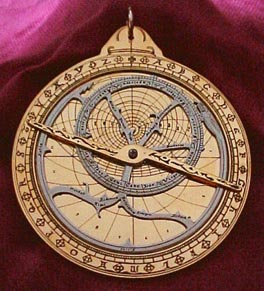
4 INCH ASTROLABE
in Gold Plate
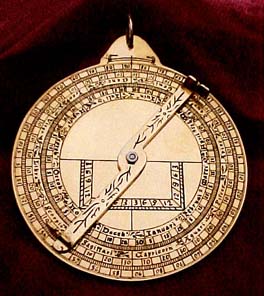
4 INCH ASTROLABE
back side
details are the same on the 3 inch model
4 inch with Bronze Finish
4 inch in Pewter finish
3 inch with Bronze Finish
3 inch in Pewter finish
The Astrolabe is cast in Pewter, and is available in a Pewter finish, Antique Bronze finish, or in the Gold plate. It has 17 stars listed as well as a map of the sky overhead (for 37 degrees) and the ecliptic. The time of day or night is on the outside edge with noon at the top of the Astrolabe and midnight at the bottom. It comes with a carrying chain, a pouch, and a book on its use. The reverse side has a sight for measuring the elevations of the heavenly bodies. The 3 inch size has the same details as the 4 inch. It is a reduced version of the 4 inch. It is also available in all white (pewter), Antique Bronze finish, or in gold plate.
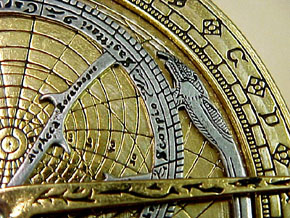
Detail of markings on the 4 inch Astrolabe
Time is shown A B C for 1, 2, and 3 o'clock etc.
Star points are labeled
Time of year is given in the degrees of the Zodiac Calander
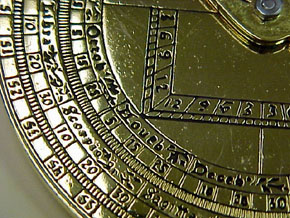
Degree scale for altitude measurements on outer rim
Calandar and Zodiac reference second in
Shadow square near center
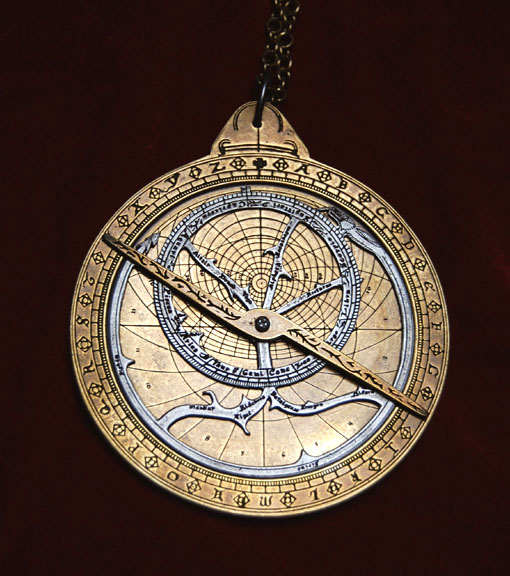
The 4 inch Astrolabe in the Bronze finish.
It is not as shiny as the Gold finish.
The Astrolabes that have the map of the sky cast into it, as above, do not fit the plates that come with the following Astrolabe. They do not have the space inside for any of the plates.
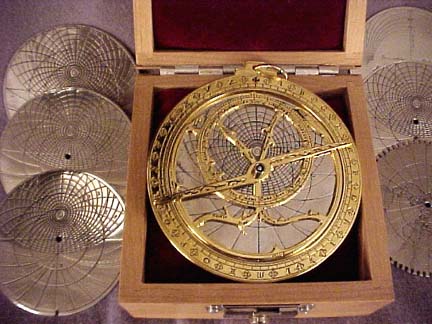
4 inch ASTROLABE with 8 plates for adjustable latitude
Includes Wood case
Pewter finish
Gold/Pewter
The Astrolabe was developed at the Greek school in Alexandria about 160 B.C. by Hipparchus. Great scientific strides forward at that time were the result of combining the Greek sciences with Babylonian mathematics. This was all made possible by the conquests of Alexander the Great who established a vast empire throughout the Mediterranean. The Astrolabe was known to scholars from then on, and was used as a slide rule of the Heavens. Direction, time, angles, and the position of the celestial bodies could all be calculated. When Prince Henry the Navigator established his seafaring fleet, he began using the Astrolabe to navigate the ships. For many years, this gave the Portuguese the exclusive ability to navigate open waters, which the other countries could not do. When Sir Francis Drake raided ports along the South American coast he was forced to flee from the Spanish ships. Drake attacked a Portuguese ship and took its Navigator hostage to guide him on his round the world voyage, thus avoiding the Spanish Fleet. All the great voyagers in the age of exploration navigated with the Astrolabe, including Columbus, Magellan, and Drake.
About 1391 Chaucer wrote his Treatise on the Astrolabe for his son. All scientific texts were written in Latin, so that scholars everywhere could read them. But Chaucer's son was too young at 10 to read Latin, so Chaucer's instructions to his son became the first scientific text written in English.
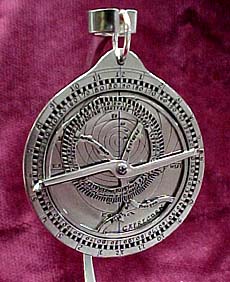
2 3/4 inch ASTROLABE
Pewter finish
Gold finish
This smaller Astrolabe lists 7 stars and takes its elevations with the front pointer. The map of the sky has elevations every 10 degrees, as opposed to every 5 degrees on the larger Astrolabe. It is available in the pewter finish or gold plated. It includes a carrying chain and pouch, as well as a book on its use.
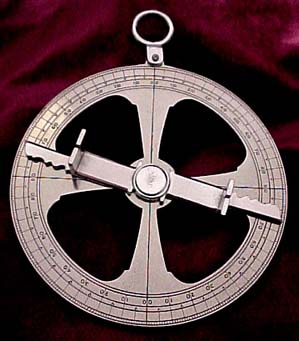
5 1/2 INCH MARINER'S ASTROLABE
PEWTER FINISH